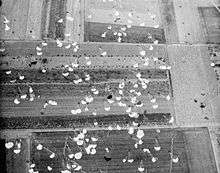Secret Army (Belgium)
| Secret Army Armée Secrète (French) Geheim Leger (Dutch) | |
|---|---|
| Participant in the Belgian Resistance (World War II) | |
 Uniformed members of the Secret Army with a Canadian soldier in Bruges in September 1944 | |
| Active | August 1940–October 1944 |
| Ideology | Right wing, Catholic, Leopoldist |
| Leaders |
Charles Claser Jules Bastin Jules Pire |
| Area of operations | Belgium |
| Size | 54,000 men (1944) |
| Originated as |
Belgian Legion Reconstructed Belgian Army Army of Belgium |
The Secret Army (French: Armée Secrète or AS, Dutch: Geheim Leger, GL) was the largest group within the Belgian Resistance active during the German occupation of Belgium during World War II. Founded in August 1940 as the "Belgian Legion", the Secret Army changed its name on a number of occasions during its existence, adopting its final appellation in June 1944. Politically conservative and royalist, the Secret Army was also one of the groups which enjoyed the closest relations with the Belgian government in exile in London.
Foundation
The origin of the Secret Army can be traced back to shortly after the Belgian surrender after the German invasion of 10–28 May 1940. A number of career officers from the defeated Belgian Army joined together to create the first small resistance organisations, such as the "Belgian Legion" (Légion Belge or Belgisch Legioen) and "Reconstructed Belgian Army" (Armée Belge Reconstituée or Heropgericht Belgisch Leger). The members involved were generally right-wing authoritarians in their political views and strongly identified with King Leopold III, expressing hostility towards Belgian politicians and communists as well as the German occupiers.[1] In the spring of 1941, the Reconstructed Belgian Army and Belgian Legion merged, keeping the Belgian Legion name, under the leadership of Charles Claser, Robert Lentz and Jules Bastin.[2] The organisation had units across the country, with as many as 50,000 members, and its own local organisation.[2][3]
Activities

The group's leaders attempted to forge contacts with the Belgian government in London and with the British Special Operations Executive (SOE) and MI9. In 1942, Claser travelled to London in person to bring the organisation into contact with both the Belgian and British authorities.[4] The Belgian government, however, distrusted the intentions of the Belgian Legion.[5] Although expanding rapidly, the Belgian Legion was beset by internal political disputes. Arrests of leading resistance members also destabilised the movement.[1] By the liberation, Claser, Lentz and Bastin had all been arrested.[3]
In 1943, the Belgian Legion changed its name to "Army of Belgium" (Armée de Belgique or Leger van België) and subsequently to the Secret Army (Armée Secrete or Geheim Leger) in June 1944. Between 1943 and 1944, the majority of the aid sent to the resistance in occupied Belgium was delivered to the group.[1] In exchange, however, the group had to subscribe to the government's strategic plans to avoid confrontation with the Germans until shortly before the Liberation of Belgium when the group was tasked with providing tactical help to the Allied forces.[1] Relations between the Belgian government and the Secret Army remained tense throughout the war, however, with neither party trusting the other.[6] In February 1944, Jules Pire took over as its leader and began to restructure the group's leadership and make it more cohesive.[7][8] As part of its attempt to resemble an official army, the group even adopted its own form of uniform in April 1944.[9]
Shortly after D-Day in June 1944, the Secret Army was ordered to begin sabotaging railway and communications networks.[10] Together with other groups including the Front de l'Indépendance and Witte Brigade, Secret Army personnel played an important role in the capture of the Port of Antwerp in September 1944 before the arrival of Canadian troops, preventing the Germans from destroying the installation as they prepared to retreat.[11]
At its height in 1944, the Secret Army had as many as 54,000 members across Belgium. Around 4,000 members of the Secret Army were killed during the occupation. After the liberation, many members of the Secret Army were incorporated into the re-formed Belgian Army's new Fusilier Battalions. As many as 80 percent of the 53,700 soldiers in the battalions had previously been members of the Secret Army or the small National Royalist Movement.[12]
References
- 1 2 3 4 Dujardin & Van den Wijngaert 2010, p. 72.
- 1 2 Bernard 1986, p. 14.
- 1 2 Deleuze 1958, p. 45.
- ↑ Bernard 1986, pp. 24-5.
- ↑ Bernard 1986, p. 34.
- ↑ Conway 2012, pp. 36-8.
- ↑ Deleuze 1958, p. 48.
- ↑ Conway 2012, pp. 37-8.
- ↑ Bernard 1986, pp. 78-9.
- ↑ Bernard 1986, p. 81.
- ↑ Dujardin & Van den Wijngaert 2010, p. 73.
- ↑ Deleuze 1958, p. 52.
Bibliography
- Bernard, Henri (1986). L'Armée Secrète, 1940-1944. Paris: Duculot. ISBN 978-2-8011-0608-2.
- Conway, Martin (2012). The Sorrows of Belgium: Liberation and Political Reconstruction, 1944-1947. Oxford: Oxford University Press. ISBN 978-0-19-969434-1.
- Deleuze, Lucien (1958). "Aperçu sur l'Armée Secrète, Groupement Militaire de Résistance Armée". Revue d'Histoire de la Deuxième Guerre Mondiale. 8 (31): 44–54. JSTOR 25731813.
- Dujardin, Vincent; Van den Wijngaert, Mark (2010). La Belgique sans Roi, 1940-1950. Nouvelle Histoire de Belgique. Brussels: Le Cri édition. ISBN 978-2-8710-6520-3.
External links
| Wikimedia Commons has media related to Secret Army (Belgium). |
- Homepage of the Secret Army Foundation.